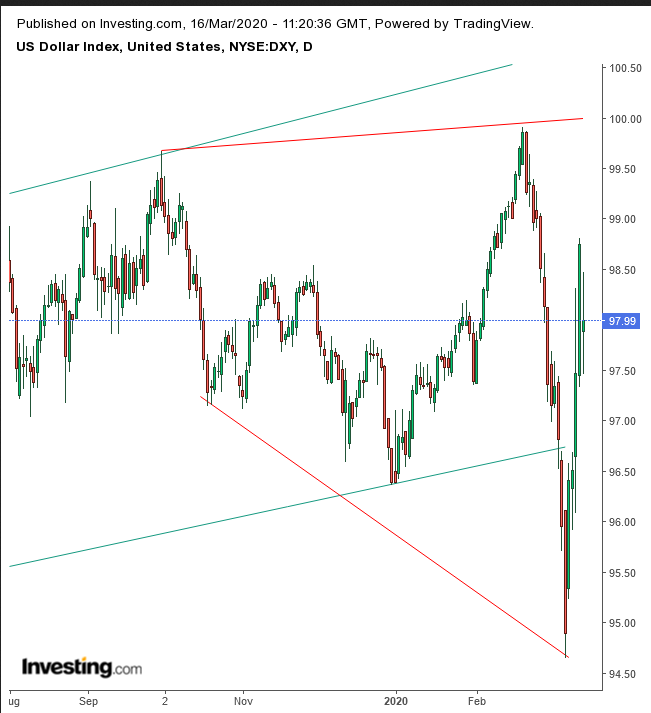The Federal Reserve made another emergency cut yesterday, slashing rates by 100 basis points to close to 0% for the first time since the 2008 financial crisis. The U.S. central bank also launched a massive, $700 billion bond buying plan.
The dollar dropped, paring half of Friday’s 1.3% surge, which had sealed its best week since 2008.
The fundamentals are pretty straightforward. However, the technical picture is confusing.

On the one hand, the dollar climbed back into a rising channel in place since July 2018. On the other, it has been developing a broadening pattern. An uptrend means that both price peaks and troughs head higher, while a downtrend is defined by both highs and lows tracking lower. A broadening pattern occurs when highs climb and lows drop, which makes it a sideways move.
However, since this pattern appears at market tops, it's considered bearish: buyers lose patience when the lows don’t join the highs with higher prices and they eventually join the sellers.
Nonetheless, equities entered both a bear market and a downtrend. In practical terms that means declines should be trusted while rallies are suspect. In this scenario they're nothing more than corrective moves higher within a downtrend—fueled by profit-taking or short covering that increases demand and those hopeful enough to be willing to trade against the trend.
U.S. futures also sank 5% today, triggering limit-downs and suggesting the underlying indices will continue selling off as the coronavirus pandemic intensifies worldwide, with more businesses announcing mass store closings.
In previous crashes, the dollar became the ultimate safe haven asset, and we expect it to become that again. However, we do anticipate it will whipsaw violently before establishing a clear trend, up or down.
Trading Strategies
Conservative traders would wait for two rising highs and lows to buy, or for two falling highs and lows to short.
Moderate traders would go long after an upside breakout, which consolidates a base above the sideways patterns. Alternatively, they would do the same thing upon a downside breakout and a return move toward the pattern that fails, solidifying a top. Or they may go long if the dollar either falls to 95, the pattern bottom, or passes 100, providing an upside breakout to the sideways move.
Aggressive traders may buy if the price returns toward the bottom of the pattern and after breaking its topside.
Trade Sample
- Entry: 95:00
- Stop-Loss: 94:00
- Risk: 100 pips
- Target: 100.00
- Reward: 500 pips
- Risk:Reward Ratio: 1:5
